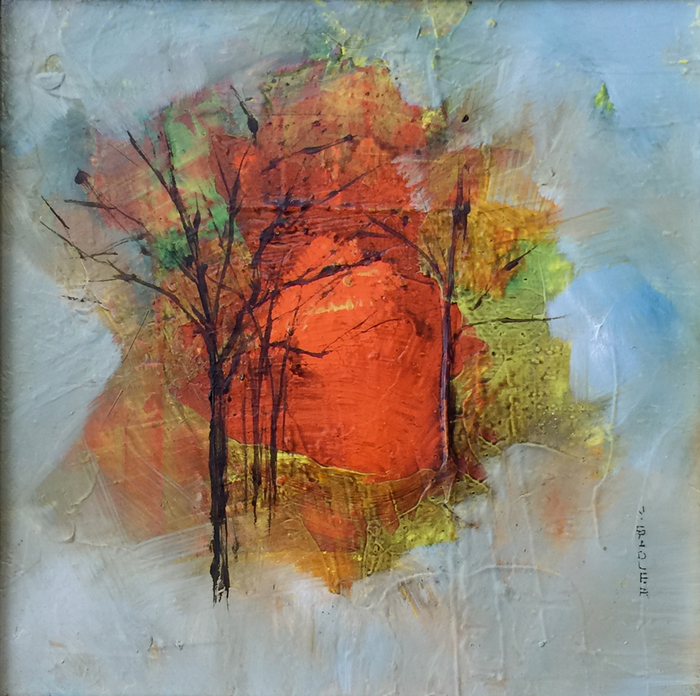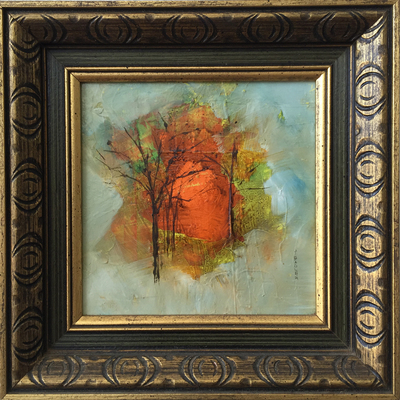Robert J. Sadler
-
- Robert J. Sadler
- (1909-2001)
- London, England Artist
- Image Size: 5.5 x 5.5
- Frame Size: 9 x 9
- Medium: Oil
- Untitled
- Contact for Price & Info
- View All By This Artist
Details
Mid Century Modern
-
Biography
Robert J. Sadler (1909-2001)
Robert Sadler (1909-2001)
Robert Sadler was born in Newmarket, England in 1909, the second son of Harry Sadler (a well-known racehorse trainer) and Ada Sadler (neé Lane). He showed great promise at drawing and painting as a child.
Robert was sent to boarding school at Eastbourne College, and from there he went to Sidney Sussex College, Cambridge, to read Mechanical Engineering. At Cambridge he joined the University Air Squadron, where he learned to fly, and in 1930 joined the Royal Air Force as a Pilot Officer. For a while he was the personal pilot of the C-in-C of the RAF, Sir John Steel, flying him around in a Hawker Hart with the open rear cockpit converted into a desk for the great man to do his paperwork (at over 150 mph!). Some drawings survive from this period.
In 1935 Robert was married to Madeleine Leach (neé Langley) widow of the trainer Felix Leach Junior. They were together for 66 years until his death in 2001. His widow lived until 2011 and died aged 106.
Robert's RAF postings included Duxford, Central Flying School, Cranwell Staff College, Northolt (RAF HQ), Alexandria (Egypt) and Invergordon (Scotland), but shortly after the outbreak of the Second World War Robert was posted to France as a staff officer with the Advanced Air Striking Force. The obsolete Fairey Battle bombers of the AASF suffered terribly, and even the Hurricane fighters could not stem the overwhelming numerical superiority of the Luftwaffe. After the debacle of the German breakthrough and the evacuation at Dunkirk, Robert found himself retreating westwards into Brittany, before finally getting a flight back to Britain with nothing but the uniform he stood up in and a splendid wireless set he had hired in Rheims. At one point the staff were based in the Pommery Champagne cellars, where Guy de Pommery (liaison officer between the British and French air forces) gave his consent to the evacuation of two lorry loads of champagne "pour assister le rétrait du RAF". Sadly this, and almost all other equipment, was lost.
Robert was next posted to command RAF bomber squadrons in England converting to the new twin-engined Vickers Wellington bombers, the first RAF bomber in which the crew were dispersed throughout the aircraft, rather than being concentrated in one cockpit or cabin. To his amazement, Robert found that the RAF had issued no guidelines to captains of such aircraft on how they should train and manage the aircrew, and maintain morale. He at once drafted his own guidelines, many of which were subsequently taken up officially by the RAF. In these early days of operations over Germany Robert maintained that they rarely saw the ground and almost never found the target.
In 1942 Robert moved to Plans at the Air Ministry in London, which gave him his first real chance to attend art school (Hatherly's) and develop the skills he yearned to make more use of. But in 1943 (shortly after the birth of his son, Robin) he was posted to Turkey, ostensibly as an instructor at the Turkish Air Staff College, but with the covert mission of helping to dissuade the Turks from entering the war on the German side by extolling the virtues of the RAF and the certainty of an eventual Allied victory. He flew out (without his family - this was wartime) in the converted bomb bay of a Liberator (a common way to travel in wartime) but once there he found the conditions in Turkey utterly delightful and a far cry from blacked-out Britain. He lodged in Ankara with the First Secretary of the British Embassy, Douglas Busk, whose valet was later to achieve infamy as the German spy "Cicero".
With only a modest schedule of lectures to deliver at the Staff College, Robert was at last able to indulge again in his two passions - painting and horses. He would take his easel and water colours out into the countryside, accompanying Bridget Busk (wife of the First Secretary). On one occasion he was arrested by the Turkish army because (unknown to him) a camouflaged ammunition dump lay in the middle distance of his water colour, but all was explained and forgiven over several cups of Turkish coffee. He was also able to afford to keep and race his own racehorse "Chammosaire" and a groom to look after it, on the pay of a Wing Commander. A self-portrait of him "up" on Chammosaire survives.
The Turks did not join the Germans, and in fact declared for the Allies just before VE-day. Robert returned to England as Station Commander at Binbrook in Lincolnshire, where 617 (Dam Buster) Squadron was then based. The base was near a German prisoner of war camp, and many of the prisoners were fearful of returning to a divided Germany, especially Eastern Germany which was occupied by the Russians. While awaiting for repatriation many of the prisoners worked around the air station and in the married quarters of the officers. Forty five years later (after the fall of the Berlin Wall) Robert and Maddie received a letter from one of the officer POW's, who recounted how grateful they had been for their good treatment by the RAF at that time. This correspondence continued for some time.
In 1947 Robert received a Diplomatic posting as Air Attaché to the British Embassy in Copenhagen. Once again Denmark and diplomatic privileges provided a living standard that was a far cry from the deprivation of post-war Britain with its rationing. Robert continued to do some painting in Denmark (mainly still lives and landscapes in oils), and attended art school in Copenhagen, before returning to Suffolk in 1949, to live close to his brother Jack who was by now farming at Cheveley, where Robert painted some more landscapes.
In 1950 Robert was posted to the RAF Officer Selection Board at Andover as vice-chairman, and rented a house near Stockbridge. A large hut in the garden provided Robert with his first real artist's studio, and he began to devote more time to painting, taking his sketchbook, water colours and pastels out into the countryside, and turning other ideas into paintings in his studio. He attended Winchester School of Art and also did thumbnail sketches of the young men applying to be RAF officers, to help him remember who was who.
Robert's final RAF posting came in 1952, when he went to the Pentagon in Washington DC as one of the three-man intelligence committee for the NATO Joint Chiefs of Staff. The committee comprised an American Colonel, a French Colonel, the English Group Captain (Robert) and an American secretary. In this role Robert collated and disseminated NATO intelligence to all the NATO countries, travelling extensively around Europe to do so. While in the USA, Robert was again able to take up painting, especially on one holiday with his family in Martha's Vineyard, and several watercolours survive from this trip. He also attended the Corcoran Gallery Art School in Washington DC.
But it was on his return to England in 1954 that Robert's real love of painting took hold. Seeing little hope of further advancement in the RAF, he took early retirement " to devote the rest of my life to painting". He lived at first near Newmarket, to be close to his ailing mother. Once again he had a proper studio and most of his large and more exciting abstract expressionist paintings date from this period, influenced by Jackson Pollock in the USA and Nicholas de Stael (in France). Robert also returned at times to an earlier love of painting horses, and accompanied Sir Alfred Munnings on several occasions on Newmarket Heath to do so.
While painting at Newmarket Robert joined the Cambridge Society of Painters and Sculptors and showed work at their annual exhibitions in 1960 and 1961. His work was also exhibited at the Industrial Britain Exhibition (1956), The John Moores Liverpool Exhibition (1957/8), The Royal Institute of Painters in Water Colours (1955), The Royal Institute of Oil Painters (1955 and 1957), The Royal Institute Galleries Summer Salon (1955), Artists of Chelsea (1958), Bradford City Art Gallery (1959), Gainsborough House Society (1962), CEMA Belfast (1962), and Saffron Walden Festival (1962), as well as at commercial galleries in the UK and USA.
In 1963/4 (after the death of his mother at Newmarket) Robert Sadler moved his family to Aldeburgh on the East Suffolk coast, where he built a new studio in the garden of their home, in which he held a one-man show during the Aldeburgh Festival almost every year until 2001. During these years his work was also exhibited at The Royal Institute Gallery (1969), East Anglian Art Today, London (1969), the European Parliament at Strasbourg (1985/86), New English Art Club, Centenary Exhibition (1986), and at commercial galleries in Britain and the USA. During these years he painted mainly smaller landscapes (as if seen from a low-flying aircraft), still lifes, figures and sometimes horses, but often turned again to the abstract expressionism for which he is best known. In the 46 years in which he painted full-time (1955-2001) Robert sold some 2,000 paintings; a further 1,000 or more are now held in trust by his son Robin Sadler.
While living in Aldeburgh Robert Sadler enjoyed his hobbies of yacht racing and golf, and earned honorary life membership of the Aldeburgh Golf Club by designing and constructing a nine-hole course to supplement the older 18-hole course. Robert Sadler died in August, 2001 and his ashes were scattered (as he wished) on the golf course he designed.
In June 2000, Caroline McAdam Clark wrote in her Aldeburgh Art Trail notes for the Aldeburgh Festival:
"In traditional Aldeburgh mode, the art trail strikes out beyond the High Street and up the Town Steps to Robert Sadler's studio on the Terrace … Climbing up the spiral staircase to visit Robert Sadler's studio, where his very beautiful abstract paintings are displayed and stacked in piles all around the floor and on tables and chests, is less like visiting an exhibition and more like being allowed a privileged and intimate glimpse behind the scenes of an artist's working space. A fixture on the Aldeburgh calendar for over thirty years, this cannot be missed."
Around 2,000 paintings were sold by the artist over the years 1955-2001.

